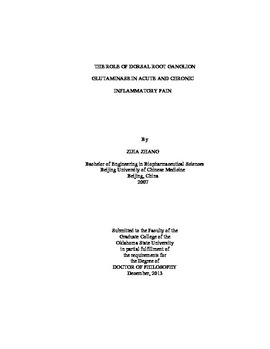| dc.contributor.advisor | Miller, Kenneth E. | |
| dc.contributor.author | Zhang, Zijia | |
| dc.date.accessioned | 2015-06-17T20:08:50Z | |
| dc.date.available | 2015-06-17T20:08:50Z | |
| dc.date.issued | 2013-12 | |
| dc.identifier.uri | https://hdl.handle.net/11244/15217 | |
| dc.description.abstract | Scope and methods of the study. | |
| dc.description.abstract | The purpose of this study was to provide further evidence to support the concept that dorsal root ganglion (DRG) glutaminase, the synthetic enzyme for the neurotransmitter glutamate, is a potential target for analgesic therapeutics. Behavioral study, fluorescent microscopy and quantitative image analysis were used to investigate the temporal expression of DRG glutaminase after peripheral inflammation. The role of tonic glutaminase and glutamate in initiating acute and chronic inflammatory pain was also explored. | |
| dc.description.abstract | Findings and Conclusions. | |
| dc.description.abstract | Significant elevation of glutaminase was observed in subpopulations of DRG neurons that were labeled with nociception-related neuropeptide markers in small- to medium sized neuronal cell bodies. Elevated glutaminase was also found in peripheral nerve during acute phase of inflammation. These results indicated that after inflammation, elevated glutaminase was synthesized in the neuronal cell bodies and then transported to the peripheral nerve terminals around the inflamed site, where glutamate was produced and released contributing to peripheral sensitization. Inhibition of glutaminase at the peripheral nerve terminal prior to inflammation 1) achieved robust long-term anti-edema and anti-nociceptive effects; 2) inhibited the inflammation-induced elevation of glutaminase in the peptidergic DRG neuronal cell bodies. These results supported the notion that after the onset of inflammation, tonic or early glutamate production at peripheral nerve terminal had a "feed-forward" mechanism by up-regulating glutaminase synthesis in DRG neurons. It suggested that early treatment that targeted the acute glutamate production at the peripheral terminal might prevent the development of chronic pain and/or provide more effective alleviation if the pain continues into the chronic phase with the pathology. With further understanding of the role of dorsal root ganglion glutaminase in acute and chronic inflammatory pain, it was rational to propose that glutaminase and glutamate metabolism can be novel potential targets for analgesic therapeutics. | |
| dc.format | application/pdf | |
| dc.language | en_US | |
| dc.rights | Copyright is held by the author who has granted the Oklahoma State University Library the non-exclusive right to share this material in its institutional repository. Contact Digital Library Services at lib-dls@okstate.edu or 405-744-9161 for the permission policy on the use, reproduction or distribution of this material. | |
| dc.title | Role of dorsal root ganglion glutaminase in acute and chronic inflammatory pain | |
| dc.contributor.committeeMember | Patneau, Doris K. | |
| dc.contributor.committeeMember | Wilson, Nedra F. | |
| dc.contributor.committeeMember | Rouch, Alexander J. | |
| dc.contributor.committeeMember | Davis, Randall L. | |
| dc.contributor.committeeMember | Vashaee, Daryoosh | |
| osu.filename | Zhang_okstate_0664D_13161.pdf | |
| osu.accesstype | Open Access | |
| dc.type.genre | Dissertation | |
| dc.type.material | Text | |
| dc.subject.keywords | dorsal root ganglion | |
| dc.subject.keywords | glutamate metabolism | |
| dc.subject.keywords | glutaminase | |
| dc.subject.keywords | inflammatory pain | |
| dc.subject.keywords | nociception | |
| dc.subject.keywords | quantitative image analysis | |
| thesis.degree.discipline | Biomedical Sciences | |
| thesis.degree.grantor | Oklahoma State University | |
